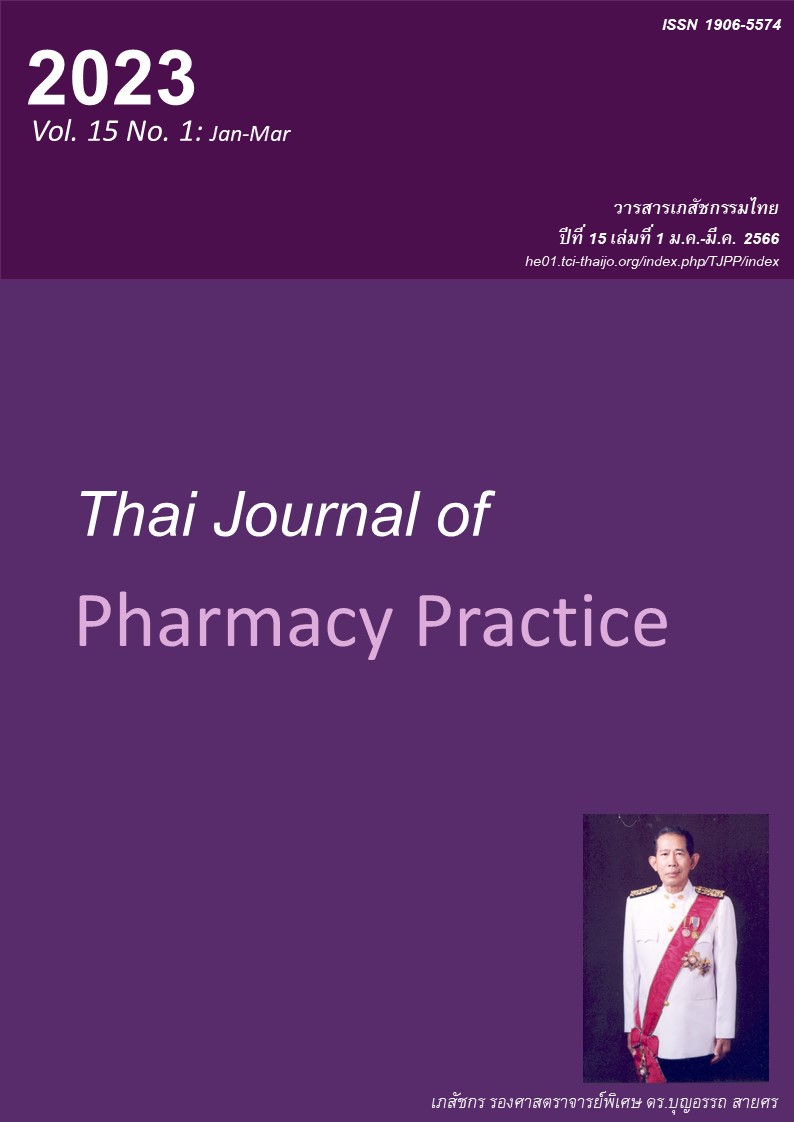พฤติกรรมของผู้บริโภคในการเลือกซื้อเครื่องสำอางจากกล้วยที่ใช้บนใบหน้าที่มีจำหน่ายในประเทศไทย
Main Article Content
บทคัดย่อ
วัตถุประสงค์: เพื่อศึกษาความรู้ ทัศนคติ พฤติกรรม และความต้องการใช้ผลิตภัณฑ์เครื่องสำอางจากกล้วยที่ใช้บนใบหน้า (facial cosmetics from banana: FCB) ของผู้บริโภค วิธีการ: การศึกษาเป็นการวิจัยแบบผสมผสาน ได้แก่ การวิจัยเชิงปริมาณและการวิจัยเชิงคุณภาพ ในการวิจัยเชิงปริมาณ ผู้วิจัยเก็บข้อมูลโดยใช้แบบสอบถามออนไลน์จาก ผู้บริโภคทั้งชายและหญิงที่มีอายุตั้งแต่ 15-60 ปี และใช้เครื่องสำอางบนใบหน้าเป็นประจำ ส่วนการวิจัยเชิงคุณภาพใช้การสัมภาษณ์เชิงลึกในผู้บริโภค 10 คนที่มีลักษณะเดียวกับตัวอย่างในการวิจัยเชิงปริมาณ โดยประกอบด้วยผู้ที่มีประสบการณ์การใช้และไม่เคยใช้ FCB ผลการวิจัย: ในการศึกษาเชิงปริมาณ ผู้ตอบแบบสอบถาม 402 คน ส่วนใหญ่เป็นเพศหญิงและอยู่ในวัยทำงาน กลุ่มตัวอย่างไม่เคยใช้ FCB 395 ราย (ร้อยละ 98.30) กลุ่มตัวอย่างที่เคยใช้ FCB ใช้ในรูปของเครื่องสำอางบำรุงผิวหน้ามากที่สุด (ร้อยละ 85.70) กลุ่มตัวอย่างมีความรู้เกี่ยวกับการใช้เครื่องสำอางในระดับดี (ร้อยละ 83.30) สำหรับทัศนคติ พบว่า กลุ่มตัวอย่างให้ความสำคัญต่อปัจจัยด้านคุณภาพผลิตภัณฑ์และราคามากที่สุดในการเลือกซื้อผลิตภัณฑ์เครื่องสำอาง ความรู้มีความสัมพันธ์กับความต้องการใช้ ในการศึกษาเชิงคุณภาพ ผู้ให้ข้อมูลให้ความสำคัญด้านคุณภาพผลิตภัณฑ์มากที่สุด นั่นคือ การที่วัตถุดิบมาจากธรรมชาติและราคาที่เหมาะสม สรุป: กลุ่มตัวอย่างส่วนใหญ่ไม่เคยใช้ FCB มีความรู้เกี่ยวกับการใช้เครื่องสำอางในระดับดี และให้ความสำคัญต่อปัจจัยด้านคุณภาพผลิตภัณฑ์และราคา
Article Details

อนุญาตภายใต้เงื่อนไข Creative Commons Attribution-NonCommercial-NoDerivatives 4.0 International License.
ผลการวิจัยและความคิดเห็นที่ปรากฏในบทความถือเป็นความคิดเห็นและอยู่ในความรับผิดชอบของผู้นิพนธ์ มิใช่ความเห็นหรือความรับผิดชอบของกองบรรณาธิการ หรือคณะเภสัชศาสตร์ มหาวิทยาลัยสงขลานครินทร์ ทั้งนี้ไม่รวมความผิดพลาดอันเกิดจากการพิมพ์ บทความที่ได้รับการเผยแพร่โดยวารสารเภสัชกรรมไทยถือเป็นสิทธิ์ของวารสารฯ
เอกสารอ้างอิง
Wongthanasuporn N. The evolution of the definition “Cosmetics” and interesting cosmetic laws. FDA Journal 2016; 23: 80-4.
Chouhan N, Vig H, Deshmukh R. Cosmetics market [online]. 2020 [cited Feb 16, 2021]. Available from: www.alliedmarketresearch.com/cosmetics-market.
Roberts R. Cosmetics marketing industry trends [online]. 2020 [cited April 16, 2020]. Available from: commonthreadco.com/blogs/coachs-corner/cosmeti cs-marketing-industry-trends#cosmetics-industry-da ta.
Kasikorn Research Center. Cosmetics market in the situation of covid 19 epidemic [online]. 2020 [cited Dec 16, 2020]. Available from: kasikornresearch. com/th/analysis/k-social-media/Pages/cosmetic_mar ket.aspx.
Department of Agricultural Extension. Banana [on line]. 2017 [cited Feb 3, 2019]. Available from: www. production.doae.go.th.
Someya S, Yoshiki Y, Okubo K. Antioxidant com pounds from bananas (Musa Cavendish). Food Chem 2002; 79: 351-4.
Jumroon A, Youryon P, Joyroy B. Analysis of antioxidant Activity in Musa (ABB group) ‘Kluai Hin’ and Musa (AA group) ‘Kluai Leb Mu Nang’. Songkla nakarin Journal of Plant Science 2015; 2: 38-42.
Yoo DS, Jang SJ, Park YJ, Kim HS, Hwang HS. Whitening effect of banana leaf extract. J Soc Cosmet Sci Korea 2016; 42: 37-43.
Lin Y-H, Lin Y-T. Method for promotion hair growth using banana stamen extract. Patent No. US 10,58 8,932 B2 2020.
Noysang C, Buranasukhon W, Khuanekkaphan M. Phytochemicals and pharmacological activities from banana fruits of several Musa Species for using as cosmetic raw materials. Appl Mech Mater 2019; 891: 30–40.
Pereira A, Maraschin M. Banana (Musa spp) from peel to pulp: ethnopharmacology, source of bio active compounds and its relevance for human health. J Ethnopharmacol 2015; 160: 149–63.
Phacharapiyangkul N, T Krit, Sa-ngiamsuntorn K, Panich U, Lee CH, Chomnawang MT. Effect of sucrier banana peel extracts on inhibition of melanogenesis through the ERK Signaling pathway. Int J Med Sci 2019; 16: 602-6.
Nurittamont W, Phayaphrom B, Sawatmuang P. The influence of marketing communication by social media influencer on purchasing decision toward cosmetic. RMUTI Journal Humanities and Social Sciences 2020; 7: 83-97.
Saneechai W, Kruewiriyaphan S, Na-Pomphet K. Behavior and marketing factors affecting the choice of herbal cosmetics in bangkok metropolis area. King Mongkut’s Agricultural Journal 2017; 30: 71-9.
Sengpanich U. Marketing mix influencing a decision on purchasing herbal cosmetics of the customers in Phitsanulok. Journal of Management Science Pibulsongkram Rajabhat University 2019; 1: 104-17.
Chansuwan R, Sahapattana P. Factors affecting herbal cosmetic consumption behaviors. Journal of Politics, Administration and Law 2015; 8: 293-321.
Samerjai C. Consumer behavior. 2nd ed. Bangkok: Se-Education; 2013.
Siranoi L. Statistical formula for determining sample size for quantitative research in the humanities and social sciences. Journal of Research and Development of Buriram Rajabhat University 2017; 12: 50-60.
Rattanawijit A. Behavior and factors affecting consumers of food supplements in Bangkok [master thesis]. Bangkok: Bangkok University; 2009.
Chantuma R, Khamanarong S. The development for competition of herbal facial cosmetic industries: a case study of Khon Kaen province. KKU Research Journal of Humanities and Social Sciences (Graduate Studies) 2013; 3: 1638-44.
Siriwan P. The use of herbal medicine base on knowledge, attitude and perception of service providers and users in Mae Tha hospital, Mae tha District, Lamphun Province [independent study]. Bangkok: Thammasat University; 2016.
Deangpatiw H. Marketing mix, attitudes and motives affecting the purchasing decision in in nutritional supplements for whitening skin of teenagers in Bangkok [independent study]. Bangkok: Bangkok University; 2016.
Apipawinwongsa P. The study of eastern and western consumer behavior in purchasing and using facial cosmetic [independent study]. Bangkok: Tham masart University; 2014.
Kongchuen W, Lerkiatbundit S. Development of risk assessment criteria for contamination with hazardous substances in facial cosmetics. Thai Journal of Pharmacy Practice 2020; 12: 814-824.
Chaipichit N, Chaiprom Y, Jeamthai T, Kamnak P, Pakornkitarpa P. Effectiveness of utilizing decision aids for selecting safe skincare cosmetics. Thai Journal of Pharmacy Practice 2020; 12: 494-504.


